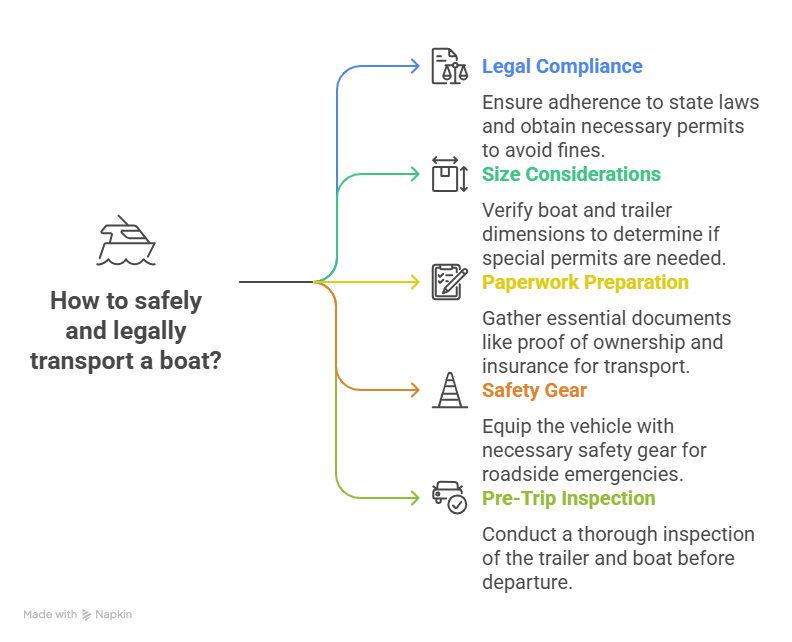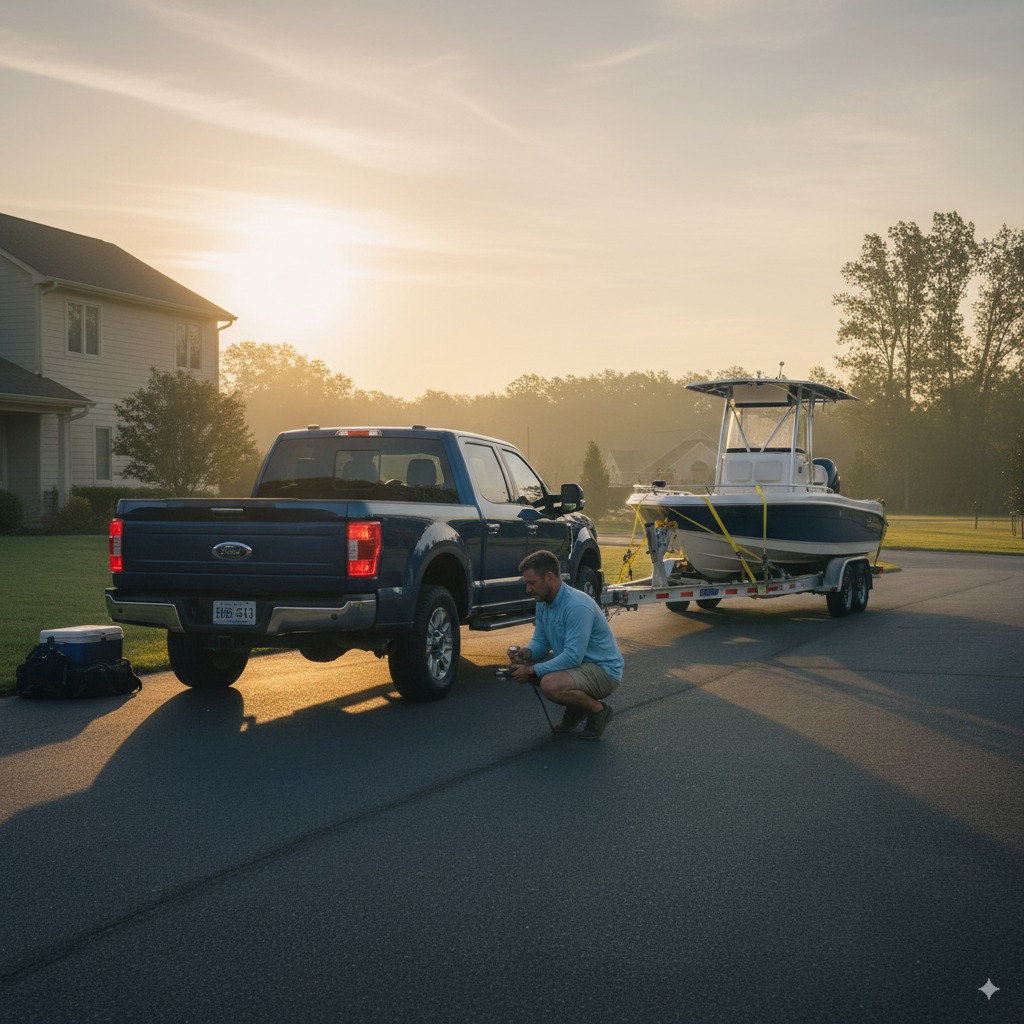I’ve spent countless hours getting boats ready for the water, but some of the most stressful moments for my clients happen before they even get near a launch ramp. It’s the journey itself—the long haul on the highway. This is where a good day can go bad, fast.
I’ll never forget a call I got from a guy named Mike. He was on the side of I-95, halfway to the Keys. His brand-new trailer had thrown a wheel bearing because he’d never serviced it. His boat was listing, his family was waiting, and his dream weekend was turning into a roadside nightmare. This is the part of Transporting Your Boat: Regulations and Tips that people often forget—the “tips” are just as crucial as the “regulations.”
Let’s be honest, towing a boat can be intimidating. There’s a tangled web of rules, and a lot can go wrong. But it doesn’t have to be that way. With a bit of know-how and preparation, you can make every trip smooth and predictable.
This guide is my brain dump of 15 years of experience. I’m going to walk you through the real-world stuff—the regulations that actually matter, the pre-trip checks that save your skin, and the smart driving habits that keep you out of trouble. This isn’t just a list of rules; this is a playbook for successful Transporting Your Boat: Regulations and Tips.
Table of Contents
Untangling the Rules: What You Actually Need to Know
Before you even think about hitching up, you need to know the laws. Ignoring them is a quick way to get a hefty fine or get your boat parked on the side of the road by a state trooper.
Size Matters: Width, Height, and Permits
Most states stick to a standard limit: 8 feet 6 inches wide and 13 feet 6 inches high. If your boat on its trailer is wider or taller than that, you’re in “oversize load” territory. This means you’ll need special permits for every state you travel through. These rules are a critical part of Transporting Your Boat: Regulations and Tips.
For really big boats, you might even need a pilot car to escort you. Don’t guess on this. Check the Department of Transportation (DOT) website for every state on your route.
Paperwork: Your Golden Tickets
Always have these in your truck, ready to go:
- Proof of boat ownership (title or bill of sale)
- Current boat and trailer registration
- Proof of insurance that covers transport
If you’re crossing state lines with a heavy rig (over 26,000 lbs combined), you might need more complex permits like IFTA for fuel taxes. This aspect of Transporting Your Boat: Regulations and Tips is often overlooked by casual towers but is critical for larger vessels.
The Right License and Safety Gear
For most boats, your standard driver’s license is fine. But for the really big stuff, you might need a Commercial Driver’s License (CDL). Check your state’s laws.
Also, things like trailer brakes, lights, and safety chains are regulated differently everywhere. Make sure your setup is legal not just where you live, but everywhere you’re going.
Before You Roll: The Pre-Trip Ritual
The most important part of any trip happens in your driveway. A thorough pre-trip inspection is what separates a smooth journey from a disaster. This is the core of smart Transporting Your Boat: Regulations and Tips.
Your Trailer Checklist
- Tires: Check the pressure (including the spare!), look for cracks, and make sure you have good tread.
- Brakes & Bearings: Test your trailer brakes. If you haven’t serviced your wheel bearings in the last year, do it. This is what happened to Mike on I-95.
- Hitch & Chains: Make sure the coupler is latched and locked. Cross your safety chains under the hitch.
- Lights: Have someone help you check every single light: brake lights, turn signals, and running lights.

Strapping It Down Right
Your boat needs to be part of the trailer, not just sitting on it.
- Use heavy-duty straps. One strong strap at the bow, and at least two at the stern, pulling down and back.
- Attach straps to the trailer frame itself, not the bunks.
- Make sure the weight is balanced. Too much weight on the hitch or too far back will cause dangerous trailer sway. A good rule of thumb is to keep your total weight under 80% of your truck’s towing capacity.
Your Roadside Emergency Kit
Don’t leave home without this:
- A good spare tire for both the truck and the trailer.
- A jack and lug wrench that fit both.
- A basic toolkit.
- Flares or reflective triangles.
- A fire extinguisher.
On the Road: Driving Smarter, Not Faster
Towing a boat changes everything about how your vehicle handles. You need to be a defensive, deliberate driver. This is the practical side of Transporting Your Boat: Regulations and Tips.
Planning Your Route
Know where you’re going. Use a GPS that accounts for your size and weight. Look for:
- Low bridges
- Steep hills
- Tight turns
Smart Driving Habits
- Go Slow: Your stopping distance is way longer. Leave plenty of room.
- Wide Turns: Swing out wider than you think you need to.
- Stop and Check: Pull over every hour or so. Put your hand on the trailer hubs. If they’re too hot to touch, your bearings are failing. Check your straps and tires. Listening to your rig is a key part of Transporting Your Boat: Regulations and Tips.
Beyond the Basics: Insurance and Trailer Choices
Insurance Check
Call your insurance agent. Don’t assume you’re covered. Ask specifically if your boat and trailer are covered for damage and liability while in transit. Sometimes you need a separate rider. This is a crucial, often missed step in Transporting Your Boat: Regulations and Tips.
Choosing the Right Trailer
If you’re in the market for a trailer, get the right one. It makes all the difference.
| Trailer Type | Best For | Pros | Cons |
|---|---|---|---|
| Bunk Trailer | V-hulls, long-term storage | Excellent support for the hull. | Harder to launch/retrieve in shallow water. |
| Roller Trailer | Varied hull shapes | Very easy to launch and retrieve. | Can create pressure points on the hull if not set up right. |
| Aluminum | Saltwater use | Lightweight and corrosion-resistant. | More expensive than steel. |
| Galvanized Steel | Freshwater/brackish use | Strong and cost-effective. | Heavy and will eventually rust in salt. |
Proper maintenance is key to trailer longevity, an essential part of Transporting Your Boat: Regulations and Tips.
FAQ: Questions I Hear All the Time
How do I know if I need an oversize permit?
If your boat on the trailer is wider than 8 feet 6 inches, you almost certainly do. Measure it. Don’t guess. The rules for Transporting Your Boat: Regulations and Tips are strict on this.
What’s the biggest mistake you see people make?
Ignoring trailer tires. They let them get old, underinflated, and sun-rotted. A trailer tire blowout at 65 mph is a truly terrifying experience.
Can my half-ton truck really pull my 8,000-pound boat?
Just because the marketing says it can doesn’t mean it should. Look at the sticker on your truck’s door jamb for the real Gross Combined Weight Rating (GCWR). Staying under 80% of that is my advice for safe Transporting Your Boat: Regulations and Tips.
How often should I service my trailer bearings?
At least once a year, or more if you dunk them in saltwater often. It’s cheap insurance against a catastrophic failure.
Do I really need trailer brakes?
Most states require them over a certain weight (often 3,000 lbs). But honestly, if your boat and trailer weigh more than your tow vehicle, you want brakes. Period.
Conclusion: Your Trip Starts at Home
Successfully Transporting Your Boat: Regulations and Tips all comes down to preparation. The time you spend in your driveway checking your gear, planning your route, and making sure you’re legal is what guarantees a smooth, stress-free trip.
You don’t need to be anxious about it. You just need to be methodical. You’re now armed with the knowledge to handle the journey with the same confidence you have on the water.
Your next trip starts now. Go out and look at your trailer. Check the tires. Make a list of what needs to be serviced. This proactive approach is what separates the pros from the people I meet on the side of the highway.
The open water is waiting. Get there safely.
Author Bio
I’m Alex, a marine technician with 15 years of experience in South Florida. I’ve seen it all when it comes to Transporting Your Boat: Regulations and Tips. From trailer bearing failures on the Alligator Alley to permit issues at the state line, I’ve helped boaters navigate the challenges of getting their vessels safely to the water and back. My focus is on practical, real-world advice that prevents problems before they start.


Leave a Reply